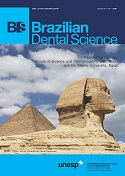Dentists’ Preferences in the Treatment of Congenitally Missing Maxillary Lateral Incisors
DOI:
https://doi.org/10.14295/bds.2019.v22i2.1710Abstract
Objective: Congenitally missing maxillary lateral incisors present challenges to dentists in terms of treatment planning and can negatively affect aesthetics and function in patients. The aim of the present study was to determine the preferred treatment approach of dentists with different specialties. Material and Methods: We carried out a descriptive, cross-sectional study using a questionnaire that was self-administered to 12 specialists in removable prosthodontics, 18 specialists in restorative dentistry, 14 specialists in orthodontics, and 173 registered general dentists. Results: General practitioners (72.7%), prosthodontists (92.9%) and, restorative dentists (80%) preferred prosthodontic replacement of missing maxillary lateral incisors, while orthodontists (57.1%) preferred canine substitution. Most general practitioners (62.7%), prosthodontists (71.4%), and orthodontists (92.9%), as well as many restorative specialists (40%), preferred implant-retained crowns for prosthetic replacement of missing lateral incisors. The dental specialties differed significantly in terms of their preferred modalities for treating children over the age of 12 years. General practitioners (56%) preferred removable partial dentures (RPDs), while a mere 17.2% preferred to carry out no treatment. All prosthodontists (100%) preferred treatment with RPDs. Restorative dentists preferred RPDs and adhesive bridges in equal number (33.3% in each case). Fifty percent of orthodontists treating children with missing lateral incisors preferred RPDs, followed by (28.6%) who preferred canine substitution. Conclusion: Preference varied for several reasons among dentists’ treating both adults and children over 12 years of age.
Keywords
Maxillary missing teeth; Dentist's preference; Teeth replacement; Dental implant.
Downloads
Downloads
Published
How to Cite
Issue
Section
License
Brazilian Dental Science uses the Creative Commons (CC-BY 4.0) license, thus preserving the integrity of articles in an open access environment. The journal allows the author to retain publishing rights without restrictions.
=================




























